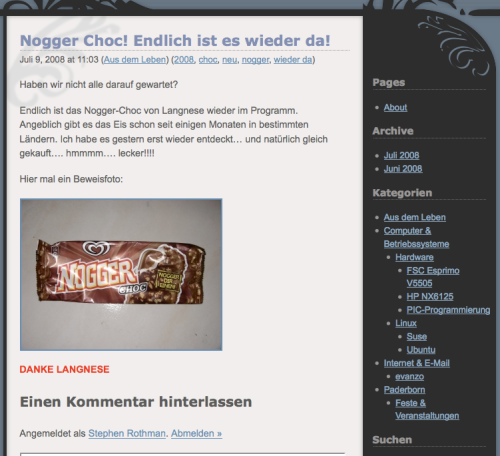The Mayo Clinic would not naturally have occurred to me as a topic for Steve’s Social Media Soapbox. Not because social media can’t create value for medical institutions and their patients. On the contrary — social media and online communities can obviously be of tremendous help to people challenged by illness, investigating treatments, dealing with the side effects of medications and coming to terms with a host of other health related issues. Similarly, the people who treat and care for patients can surely profit from the broad ranging opportunities for collaboration and sharing that social media tools offer.
But as a friend of mine who works for a health care communications agency told me, social media is fraught with legal implications and risks for pharmaceutical companies and medical institutions. For example, a drug maker that hosted a web site allowing patients to share information about a particular medication would apparently be responsible for documenting and, I believe, investigating all claims of side effects that weren’t yet covered in established protocols. There are also obvious issues with confidentially and patient privacy.

That’s why when the Mayo Clinic recently launched Sharing Mayo Clinic, a blog for patients, families and staff to share stories, it seemed to be a breakthrough. In an excellent interview with Shel Holtz on the For Immediate Release podcast (2/05/09), Lee Aase, who heads up social media for the Mayo Clinic, pointed out that there really wasn’t an issue regarding patient privacy. According to the Mayo’s lawyers, “If someone decides to tell their story on our site, that’s them disclosing their information, not us disclosing their information.” (This and other quotes of Mr. Aase are from the For Immediate Release interview.)
The upside is tremendous. In the past the Mayo Clinic posted patient stories on their web site. But these were written by a freelancer, who first interviewed the patient, and then wrote the story. According to Aase, they didn’t match the impact and authenticity of people telling their own stories in their own words as they now can do on Sharing Mayo Clinic. And clearly this transparency is much more credible and trustworthy to patients seeking information about the character and quality of treatment at Mayo. It’s also highly motivating for Mayo staffers to read these patients’ stories, which often praise the professionalism and humanity of the clinic’s personnel across the board. Finally, it also costs much less than hiring freelance writers!
Sharing Mayo is only the latest of several blogs from the Mayo Clinic. These cover — among other topics — health policy, clinic news and diseases, treatments and therapies.
Especially pioneering for a medical institution, the Mayo Clinic provides blogging guidelines to Mayo staffers and allows them to represent the clinic online. Private sector companies should take these words of Mr. Aase to heart, and recognize the potential power their companies have within the organization to communicate with customers (or in this case patients, friends and families) through engaged, well-guided and social-media savvy employees:
“We have a half a million patients a year, we have 50,000 employees, and our goal with our social media team is to engage and empower them and to get them involved in the conversation, not having the top-down kind of messaging where we try to control and script everything. My position is that we can’t afford to hire enough people to communicate all things that need to happen, but we’ve got these 50,000 employees who we’re trusting to treat patients and deal with patients everyday that they can probably handle a blog too.”
He finishes the last sentence with a chuckle, as if to say, “Wouldn’t it be silly not to entrust your employees in this way?” But so many companies have yet to free corporate communications from the iron-fist clutch of the corporate communications department. Surely the possible risks of this transparency aren’t higher for a Fortune 500 company than they are for the Mayo Clinic? And the potential benefits are the same.
The Mayo Clinic’s social media engagement goes well beyond these blogs. They run a Facebook page with at last count 4,990 fans, where you can watch videos on specific health issues and Mayo clinic treatments, link to news bulletins and the main web site, and also read stories of patients and their families. These posts of course have particular word-of-mouth value as they appear on the pages of Facebook friends, coming from the most credible and trusted source of all, people they know.
The magic of Facebook was also apparent when I clicked on photos of Mayo Clinic buildings uploaded there. I didn’t find the photos particularly good — the buildings appeared monolithic and kind of scary. A place where a patient could feel lost. But these two comments about the photos erased any such impression:
 Colleen Manley Wells (Orlando, FL) wrote
Colleen Manley Wells (Orlando, FL) wrote
at 1:24am on January 27th, 2009
Our favorite doctors in the whole wide world work in this building. Dr. Casler and Dr. Maples – the Wells family loves you!
 Jill Hughes (Trenton / Princeton, NJ) wrote
Jill Hughes (Trenton / Princeton, NJ) wrote
at 5:10pm on January 26th, 2009
my second home
What a great example of “patient generated content” improving significantly upon an institution’s own official communications.
The Mayo also produces a large number of podcasts dealing with health issues of all kinds that can be downloaded from the website or from i-Tunes.
The only reservation I had about the Mayo’s social media efforts was a statement on their Blog Comment Policy page. It said in effect that if you posted a comment on Mayo-sponsored blogs, you gave the Mayo Foundation the “irrevocable right” to “reproduce, distribute, publish, display, edit, modify, create derivative works from, and otherwise use your submission for any purpose in any form and on any media.”
This seems extreme and dictatorial. Surely, considering the personal dimension of health issues, patients who share stories and experiences on Mayo online properties, which are beneficial to the institution, its patients and its stake holders, should be permitted some say in how their contributions are used beyond their initial appearance. Perhaps it’s not an issue for many patients and their families, but I imagine that many people, presuming they read this regulation, would prefer not to tell their stories, or would not share as openly and honestly as they might otherwise. Would you? … Knowing your words could be edited and published anywhere without your permission, at any time in the future?
Other than that, I was inspired by the Mayo Clinic’s wholehearted embrace of social media and the rich and positive impressions it provided about the institution, its values and its dedication to patients and their families. If, God forbid, you are ever confronted with a serious illness, this is the place you want to be.












 Colleen Manley Wells (Orlando, FL) wrote
Colleen Manley Wells (Orlando, FL) wrote Jill Hughes (Trenton / Princeton, NJ) wrote
Jill Hughes (Trenton / Princeton, NJ) wrote
